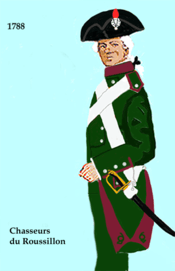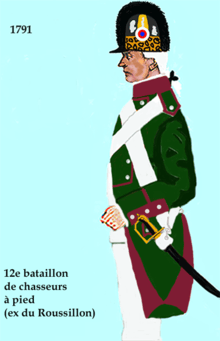Chasseurs du Roussillon
The Chasseurs du Roussillon was a light light infantry battalion of the French Royal Army which was created just before the French Revolution. The battalion would see only light service during the initial stages of the conflict with the Chasseurs des Ardennes in the Eastern Pyrenees, but its lineage ended in 1794 when it amalgamated with two volunteer battalions to form a demi-brigade. The battalion's successor, the 87éme Régiment d'Infanterie continued to service in the modern French Army until it was disbanded in 1940 following the Battle of France.
| Chasseurs du Roussillon 12éme Bataillon de Chassers (Roussillon) | |
|---|---|
 Regimental uniform after formation in 1788. | |
| Active | 1788–1794 |
| Country | |
| Allegiance | King of France French Nation |
| Branch | |
| Type | Chasseurs à Pied |
| Size | Battalion |
| Part of | Army of the Pyrenees Army of the Eastern Pyrenees Army of the Rhine Army of the Rhine and Moselle |
| Headquarters | Pont-Saint-Esprit |
Formation
The Chasseurs du Roussillon was formed from two cadres from the Régiment Royal–Italien and two full companies of the Régiment Royal–Corse, which when completed began to recruit from the counties of Roussillon and Cerdagne regions of the Eastern Pyrenees. That year, the battalion moved to Pont-Saint-Esprit and established its headquarters there. The battalion was placed 12th in precedence of the chasseurs, the last number under the desertion of the Régiment des Gardes Françaises, and placed after the Chasseurs des Ardennes.[1][2]
The regiment's first uniform consisted of; black tricone (officers in bicorne), crimson collar, dark green turnbacks, dark green jacket, dark green breeches, dark green gaiters, black boots, dark green pockets, dark green pockets, crimson cuff flaps, dark green cuffs, and white buttons.[1][3][4]
After establishing its headquarters in Pont-Saint-Esprit, the battalion then moved later that year to Alès in early 1791 just before the revolution.[2]
Revolution

On 1 April 1791, provisional regulations were announced following the initial stages of the French Revolution, and the regiment renamed as the 12éme Bataillon de Chasseurs (Roussillon), but they continued to be known as their former title until 1792. In addition to the new title, the regiment adopted a new uniform; peak casque, with stiff black horsehair crest and mock leopard skin turban helmet, crimson collar, dark green turnbacks, dark green jacket, dark green breeches, dark green gaiters, black boots, dark green pockets, dark green pockets, crimson cuff flaps, dark green cuffs, and white buttons.[1][3][4]
War of the First Coalition
Perpignan Insurrection
Just as the battalion arrived in Perpignan, the majority of the officers emigrated en mass into the local Spanish province of Catalonia. The situation worsened as soon very serious disturbing news arrived that officers of the 20th Infantry and 12th Chasseurs à Pied had planned to sneak into the town and deliver the citadel to the Spanish who were approaching from the south-west. During the night of the 6 and 7 December, these officers went to the barracks and attempted to seduce the men; but this odious scheme failed, and in the face of patriotism and courage of the 20th infantry's battalion lieutenant-colonel Desbored, who, remained the soldier of their duties, forcing the conspirators to disperse. The battalion would not remain in the area, as just a few days later they moved to Carcassonne, and from there moved to Huningue to join the Army of the Rhine Armée du Rhin.[2][5]
The Rhine
On arriving in the Rhine area, the battalion joined the occupation force of Porrentruy, Switzerland, and remained there before joining the Army of the Rhine and Moselle Armée du Rhin et Moselle until its amalgamation in 1794.[2]
The years following the Revolution saw great changes for the French Army: the old royalist infantry regiments were to serve as the stiffening for the tens of thousands of new volunteers who answered the patriotic Levée en masse. In the First Amalgamation of 1794, each old royalist battalion was put together with two new volunteers battalions to become new Demi-Brigade de Bataille or Demi-Brigade of Battle. Therefore, on 8 July 1794, the battalion amalgamated with the 3rd Battalion of the Haute-Saône and 2nd Battalion of Lot-et-Garonne to form the 12éme Demi-Brigade Légère, thus ending the royalist lineage and traditions.[1][2]
Commanding Officers
Commanding officers of the battalion were:[2]
- 1788–1791 Jean Dubois de Chantrenne
- 1791–1792 N. Commere
- 1792–1794 Charles Dégoutin de Brécourt
Footnotes
- Susane, Volume I, pp. 311, 313–314, 364, 369, 399, 404.
- Susane, Volume VII, pp. 389.
- Lienhart & Humbet, pp. 57–58.
- Smith, Uniforms of the Napoleonic Wars, p. 42–47.
- Susane, Volume IV, pp. 46–49.
References
- Louis Susane, Historie de l'Ancienne Infanterie Français, Volume I, 1849 Naval and Polytechnical Military Library of Paris, Paris, France.
- Louis Susane, Historie de l'Ancienne Infanterie Français, Volume IV, 1851 Naval and Polytechnical Military Library of Paris, Paris, France.
- Louis Susane, Historie de l'Ancienne Infanterie Français, Volume VII, 1853 Naval and Polytechnical Military Library of Paris, Paris, France.
- Dr. Constance Lienhart & Réne Humbert, The Uniforms of French Armies 1690–1894; Volume 3: The Infantry, Originally published in 1906, re-printed in 2020, Zanica, Italy. ISBN 978-8893275255.
- Digby Smith & Jeremy Black, An Illustrated Encyclopedia of Uniforms of the Napoleonic Wars, 2015 Lorenz Books, London, United Kingdom. ISBN 978-0-7548-1571-6.